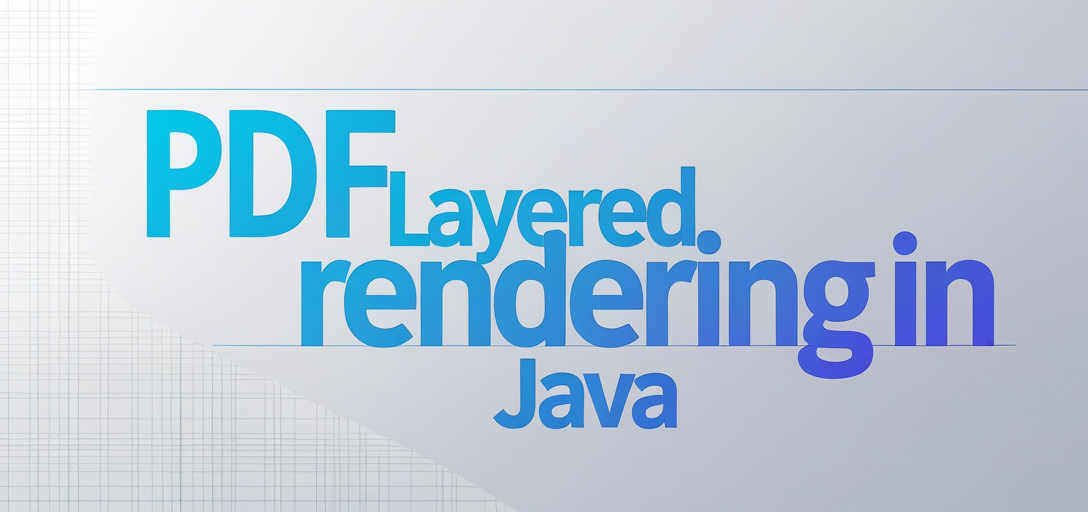Efficient PDF Layered Rendering in Java Using GroupDocs.Viewer
Introduction
Rendering complex PDFs while preserving their visual hierarchy is a challenge that layered rendering addresses effectively by respecting the Z-Index of content within source documents. This tutorial explores how to leverage GroupDocs.Viewer for Java to implement efficient PDF layered rendering.

What You’ll Learn
- Setting up GroupDocs.Viewer in your Java project
- Implementing layered rendering for PDFs using Java
- Optimizing performance with best practices in GroupDocs.Viewer
- Troubleshooting common implementation issues
Ready to dive into advanced PDF rendering? Let’s begin by setting up the necessary prerequisites.
Prerequisites
Before starting, ensure you have:
Required Libraries and Dependencies
To implement this feature, include the GroupDocs.Viewer library in your project using Maven:
Maven
<repositories>
<repository>
<id>repository.groupdocs.com</id>
<name>GroupDocs Repository</name>
<url>https://releases.groupdocs.com/viewer/java/</url>
</repository>
</repositories>
<dependencies>
<dependency>
<groupId>com.groupdocs</groupId>
<artifactId>groupdocs-viewer</artifactId>
<version>25.2</version>
</dependency>
</dependencies>
Environment Setup Requirements
Ensure you have:
- Java Development Kit (JDK) version 8 or higher installed.
- An Integrated Development Environment (IDE) such as IntelliJ IDEA, Eclipse, or VSCode.
Knowledge Prerequisites
Familiarity with basic Java programming and Maven project setup is beneficial for following this tutorial effectively.
Setting Up GroupDocs.Viewer for Java
To get started with GroupDocs.Viewer, integrate it into your Java project. Here’s how to install using Maven:
Installation Steps
- Add Repository and Dependency: As shown in the Maven configuration above, add the GroupDocs repository URL and specify the dependency for
groupdocs-viewer. - License Acquisition:
- Start with a free trial to explore features.
- For extended use, consider purchasing a license or obtaining a temporary license.
- Basic Initialization: Once installed, initialize your viewer object as shown below:
import com.groupdocs.viewer.Viewer;
import com.groupdocs.viewer.options.HtmlViewOptions;
try (Viewer viewer = new Viewer("YOUR_DOCUMENT_DIRECTORY/SAMPLE_PDF")) {
// Your rendering code will go here.
}
Implementation Guide
With GroupDocs.Viewer set up, let’s focus on implementing layered rendering for PDFs.
Layered Rendering for PDF Documents
Layered rendering allows content in a PDF to be rendered based on its Z-Index, maintaining the visual hierarchy as intended by the document creator. Here’s how you can implement it:
Step 1: Configure Output Directory and File Path Format
Set up your output directory where the rendered HTML files will be stored.
import java.nio.file.Path;
Path outputDirectory = Path.of("YOUR_OUTPUT_DIRECTORY");
Path pageFilePathFormat = outputDirectory.resolve("page_{0}.html");
Step 2: Set Up HtmlViewOptions with Layered Rendering
Configure HtmlViewOptions to enable embedded resources and layered rendering.
import com.groupdocs.viewer.options.HtmlViewOptions;
// Create HtmlViewOptions with embedded resources for PDF rendering
HtmlViewOptions viewOptions = HtmlViewOptions.forEmbeddedResources(pageFilePathFormat);
// Enable layered rendering to respect the Z-Index of content in the source PDF
viewOptions.getPdfOptions().setEnableLayeredRendering(true);
Step 3: Render the Document
Use a try-with-resources statement to render only the first page of your document.
import com.groupdocs.viewer.Viewer;
// Render only the first page with the specified options
try (Viewer viewer = new Viewer("YOUR_DOCUMENT_DIRECTORY/SAMPLE_PDF")) {
viewer.view(viewOptions, 1);
}
Troubleshooting Tips
- Ensure the output directory is writable.
- Validate that your PDF file path is correct to avoid
FileNotFoundException.
Practical Applications
Implementing layered rendering in Java can be beneficial for:
- Legal Documents: Ensuring annotations and signatures are correctly layered for legal review processes.
- Architectural Drawings: Maintaining the visual integrity of layered drawings when shared digitally.
- Educational Materials: Preserving the structure of complex educational PDFs used in e-learning platforms.
Integration Possibilities
Layered rendering can be integrated with systems requiring accurate PDF presentations, such as document management systems and digital libraries.
Performance Considerations
To ensure optimal performance while using GroupDocs.Viewer:
- Optimize resource usage by enabling embedded resources.
- Manage Java memory effectively by closing viewer instances promptly after use.
- Follow best practices for Java memory management to prevent leaks.
Conclusion
This guide covered the essentials of implementing efficient PDF layered rendering in Java with GroupDocs.Viewer. By following these steps, you can enhance your application’s ability to handle complex PDF documents accurately.
Next Steps
Consider exploring additional features offered by GroupDocs.Viewer or integrating it into larger projects for document management solutions.
Ready to implement what you’ve learned? Try out the solution and explore more advanced functionalities!
FAQ Section
- What is layered rendering in PDFs?
- Layered rendering maintains the visual hierarchy of content based on Z-Index, crucial for complex documents.
- How do I set up GroupDocs.Viewer with Maven?
- Add the repository and dependency in your
pom.xmlfile as shown in this guide.
- Add the repository and dependency in your
- Can layered rendering handle annotations effectively?
- Yes, it ensures that annotations are rendered according to their intended order.
- What Java version is required for GroupDocs.Viewer?
- JDK 8 or higher is recommended for compatibility and performance.
- Where can I get support if I encounter issues?
- Visit the GroupDocs Support Forum for assistance from the community.
Resources
Explore these resources to deepen your understanding and expand your implementation capabilities. Happy coding!